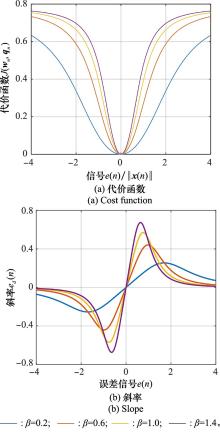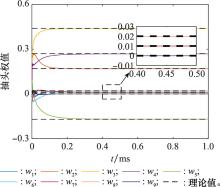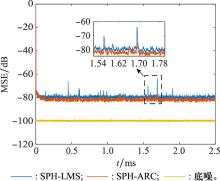Systems Engineering and Electronics ›› 2024, Vol. 46 ›› Issue (9): 2916-2925.doi: 10.12305/j.issn.1001-506X.2024.09.03
• Electronic Technology • Previous Articles Next Articles
Nonlinear self-interference cancellation technique based on spline interpolation
Zhongkai ZHAO1,2,*, Zeyue GUAN1, Hu LI3
- 1. College of Information and Communication Engineering, Harbin Engineering University, Harbin 150001, China
2. Key Laboratory of Advanced Marine Communication and Information Technology, Ministry of Industry and Information Technology, Harbin Engineering University, Harbin 150001, China
3. Beijing Aerospace Long March Aircraft Research Institute, Beijing 100076, China
-
Received:2023-06-21Online:2024-08-30Published:2024-09-12 -
Contact:Zhongkai ZHAO
CLC Number:
Cite this article
Zhongkai ZHAO, Zeyue GUAN, Hu LI. Nonlinear self-interference cancellation technique based on spline interpolation[J]. Systems Engineering and Electronics, 2024, 46(9): 2916-2925.
share this article
Table 1
Relationship between ICR and number of spline control points dB"
| 数量 | SPH-LMS | SPH-ARC | SPW-LMS | SPW-ARC |
| 5 | 30.55 | 32.01 | 29.71 | 41.67 |
| 7 | 38.88 | 39.22 | 49.10 | 50.59 |
| 9 | 43.58 | 44.05 | 49.75 | 50.14 |
| 11 | 44.82 | 45.47 | 49.97 | 50.56 |
| 13 | 45.28 | 46.17 | 49.62 | 50.72 |
| 15 | 45.40 | 46.48 | 48.98 | 50.78 |
| 17 | 45.31 | 46.55 | 48.74 | 50.72 |
| 19 | 45.34 | 46.63 | 48.79 | 50.12 |
| 21 | 45.46 | 46.74 | 48.23 | 50.53 |
| 1 |
GE S H , XING J L , LIU Y C , et al. Dual-stage co-site RF interference canceller for wideband direct-conversion receivers using reduced observation chain[J]. IEEE Trans.on Electromag- netic Compatibility, 2020, 62 (3): 923- 932.
doi: 10.1109/TEMC.2019.2914369 |
| 2 |
HONG Z H , ZHANG L , LI W , et al. Frequency-domain RF self-interference cancellation for in-band full-duplex communications[J]. IEEE Trans.on Wireless Communications, 2023, 22 (4): 2352- 2363.
doi: 10.1109/TWC.2022.3211196 |
| 3 | MORI S, MIZUTANI K, HARADA H. Digital self-interference cancellation scheme for full-duplex cellular system in 5G[C]// Proc. of the IEEE 33rd Annual International Symposium on Personal, Indoor and Mobile Radio Communications, 2022: 1165-1170. |
| 4 | ZHANG Y, LIU J, ZHOU H F. One novel method of complex direct wave suppression based on CLEAN technology[C]//Proc. of the IEEE International Symposium on Phased Array System & Technology, 2019. |
| 5 |
SHEN L , HENSON B , ZAKHAROV Y , et al. Digital self-interference cancellation for full-duplex underwater acoustic systems[J]. IEEE Trans.on Circuits and Systems Ⅱ: Express Briefs, 2020, 67 (1): 192- 196.
doi: 10.1109/TCSII.2019.2904391 |
| 6 | FICIU I D, STANCIU C L, ELISEI-ILIESCU C, et al. Low-complexity implementation of a data-reuse RLS algorithm[C]//Proc. of the 45th International Conference on Telecommunications and Signal Processing, 2022: 289-293. |
| 7 | DU Y Q, CHEN J H, LI G H, et al. Integrated self-interference suppression for single antenna full-duplex without circulator[C]// Proc. of the IEEE 20th Interregional NEWCAS Conference, 2022: 75-79. |
| 8 |
何方敏, 李毅, 孟进, 等. 基于导频的同频噪声干扰对消技术[J]. 系统工程与电子技术, 2020, 42 (5): 992- 998.
doi: 10.3969/j.issn.1001-506X.2020.05.04 |
|
HE F M , LI Y , MENG J , et al. Pilot-aided cancellation technology for co-frequency noise interference[J]. Systems Engineering and Electronics, 2020, 42 (5): 992- 998.
doi: 10.3969/j.issn.1001-506X.2020.05.04 |
|
| 9 |
LUO Y J , BI L H , ZHAO D . Adaptive digital self-interference cancellation based on fractional order LMS in LFMCW radar[J]. Journal of Systems Engineering and Electronics, 2021, 32 (3): 573- 583.
doi: 10.23919/JSEE.2021.000049 |
| 10 |
MORI S , MIZUTANI K , HARADA H . A digital self-interference cancellation scheme for in-band full-duplex-applied 5G system and its software-defined radio implementation[J]. IEEE Open Journal of Vehicular Technology, 2023, 4, 444- 456.
doi: 10.1109/OJVT.2023.3281723 |
| 11 |
KONG D H , KIL Y S , KIM S H . Neural network aided digital self-interference cancellation for full-duplex communication over time-varying channels[J]. IEEE Trans.on Vehicular Technology, 2022, 71 (6): 6201- 6213.
doi: 10.1109/TVT.2022.3158402 |
| 12 |
HUANG X , LE A T , GUO Y J . Joint analog and digital self-interference cancellation for full duplex transceiver with frequency-dependent I/Q imbalance[J]. IEEE Trans.on Wireless Communications, 2023, 22 (4): 2364- 2378.
doi: 10.1109/TWC.2022.3211316 |
| 13 |
FUKUI T , KOMATSU K , MIYAJI Y , et al. Analog self-interference cancellation using auxiliary transmitter considering IQ imbalance and amplifier nonlinearity[J]. IEEE Trans.on Wireless Communications, 2020, 19 (11): 7439- 7452.
doi: 10.1109/TWC.2020.3011467 |
| 14 |
MOHAMMADIAN A , TELLAMBURA C , VALKAMA M . Analysis of self-interference cancellation under phase noise, CFO, and IQ imbalance in GFDM full-duplex transceivers[J]. IEEE Trans.on Vehicular Technology, 2020, 69 (1): 700- 713.
doi: 10.1109/TVT.2019.2953623 |
| 15 |
YAO Y , JIN Y , LI M Y , et al. An accurate three-input nonlinear model for joint compensation of frequency-dependent I/Q imbalance and power amplifier distortion[J]. IEEE Access, 2019, 7, 140651- 140664.
doi: 10.1109/ACCESS.2019.2944025 |
| 16 |
ERDEM M , AYAR H , NAWAZ H , et al. Monostatic antenna in-band full duplex radio: performance limits and characterization[J]. IEEE Trans.on Vehicular Technology, 2019, 68 (5): 4786- 4799.
doi: 10.1109/TVT.2019.2904138 |
| 17 |
GUO W Y , ZHI Y F . Nonlinear spline Versoria prioritization optimization adaptive filter for alpha-stable clutter[J]. IEEE Trans.on Aerospace and Electronic Systems, 2023, 59 (1): 734- 744.
doi: 10.1109/TAES.2022.3188238 |
| 18 | 管鹏鑫, 汪奕汝, 赵玉萍. 基于正则化的全双工通信系统非线性自干扰消除方法[J]. 北京大学学报(自然科学版), 2021, 57 (6): 991- 996. |
| GUAN P X , WANG Y R , ZHAO Y P . A regul-arization based nonlinear self-interference suppression method for full duplex communication systems[J]. Acta Scientiarum Naturalium Universitatis Pekinensis, 2021, 57 (6): 991- 996. | |
| 19 |
ERDEM M , OZKAN H , GURBUZ O . A new online nonlinear self-interference cancelation method with random fourier features[J]. IEEE Wireless Communications Letters, 2022, 11 (7): 1379- 1383.
doi: 10.1109/LWC.2022.3170300 |
| 20 |
崔中普, 葛松虎, 李亚星, 等. 基于二维正交化WLCLMS的自干扰对消方法[J]. 系统工程与电子技术, 2022, 44 (9): 2726- 2735.
doi: 10.12305/j.issn.1001-506X.2022.09.04 |
|
CUI Z P , GE S H , LI Y X , et al. Two-dimensional orthogonalization WLCLMS scheme for self-interference cancellation[J]. Systems Engineering and Electronics, 2022, 44 (9): 2726- 2735.
doi: 10.12305/j.issn.1001-506X.2022.09.04 |
|
| 21 |
路雷, 褚建军, 唐燕群, 等. 基于卷积长短时记忆深度神经网络的带内全双工非线性数字自干扰消除[J]. 电子与信息学报, 2022, 44 (11): 3874- 3881.
doi: 10.11999/JEIT220110 |
|
LU L , CHU J J , TANG Y Q , et al. Driven non-linear digital self interference cancellation for in-band full duplex systems based on convolution long short-term memory deep neural network[J]. Journal of Electronics & Information Technology, 2022, 44 (11): 3874- 3881.
doi: 10.11999/JEIT220110 |
|
| 22 |
GHANNOUCHI F M , HAMMI O . Behavioral modeling and predistortion[J]. IEEE Micro-wave Magazine, 2009, 10 (7): 52- 64.
doi: 10.1109/MMM.2009.934516 |
| 23 | 全欣, 刘颖, 范平志, 等. 一种抑制相位噪声的多通道变时延下变频全双工收发方法[J]. 电子与信息学报, 2023, 45 (5): 1627- 1634. |
| QUAN X , LIU Y , FAN P Z , et al. A multiple-downconversion full-duplex transceiver design for phase noise suppression[J]. Journal of Electronics & Information Technology, 2023, 45 (5): 1627- 1634. | |
| 24 |
SCARPINITI M , COMMINIELLO D , PARISI R , et al. Nonlinear spline adaptive filtering[J]. Signal Processing, 2013, 93 (4): 772- 783.
doi: 10.1016/j.sigpro.2012.09.021 |
| 25 | LIU C, ZHANG Z, TANG X. Steady-state performance for the sign normalized algorithm based on Hammerstein spline adaptive filtering[C]//Proc. of the International Conference on Control, Automation and Information Sciences, 2019. |
| 26 | CAMPO P P, KORPI D, ANTTILA L, et al. Nonlinear digital cancellation in full-duplex devices using spline-based Hammerstein model[C]//Proc. of the IEEE Globecom Workshops, 2018. |
| 27 |
SCARPINITI M , COMMINIELLO D , PARISI R , et al. Hammerstein uniform cubic spline adaptive filters: learning and convergence properties[J]. Signal Processing, 2014, 100, 112- 123.
doi: 10.1016/j.sigpro.2014.01.019 |
| 28 |
SALEH A A M . Frequency-independent and frequency-depen-dent nonlinear models of twt amplifiers[J]. IEEE Trans.on Communications, 1981, 29 (11): 1715- 1720.
doi: 10.1109/TCOM.1981.1094911 |
| 29 |
YANG L D , LIU J , YAN R Q , et al. Spline adaptive filter with arctangent-momentum strategy for nonlinear system identification[J]. Signal Processing, 2019, 164, 99- 109.
doi: 10.1016/j.sigpro.2019.06.007 |
| 30 | 刘郁林. 自适应滤波算法与实现[M]. 4版 北京: 电子工业出版社, 2014. |
| LIU Y L . Adaptive filtering: algorithms and practical implementation[M]. 4th ed Beijing: Electronic Industry Press, 2014. | |
| 31 |
CAMPO P P , ANTTILA L , KORPI D , et al. Cascaded spline-based models for complex nonlinear systems: methods and applications[J]. IEEE Trans.on Signal Processing, 2021, 69, 370- 384.
doi: 10.1109/TSP.2020.3046355 |
| [1] | Gang TAN, Shefeng YAN, Zihao YE, Jirui YANG. Iterative impulsive noise mitigation and channel estimation method for OFDM system [J]. Systems Engineering and Electronics, 2024, 46(8): 2841-2849. |
| [2] | Yi MAO, Yongsheng DUAN, Zhongrui HUANG, Junning ZHANG. Direct position determination algorithm based on maximum complex correntropy target in impulsive noise environment [J]. Systems Engineering and Electronics, 2023, 45(9): 2651-2658. |
| [3] | Yan JIN, Dadi ZHAO, Hongbing JI. Parameter estimation of LFM signals based on NAT functions in impulsive noise [J]. Systems Engineering and Electronics, 2022, 44(3): 762-770. |
| [4] | Zhongtao LUO, Renming GUO, Yanmei ZHAN. Review of nonlinear transformation design for impulsive noise [J]. Systems Engineering and Electronics, 2021, 43(7): 1971-1980. |
| [5] | LI Dongxia, LIU Guoqing, LIU Haitao. Impulsive noise detection and mitigation method based onMCMC in OFDM system [J]. Systems Engineering and Electronics, 2018, 40(10): 2348-2353. |
| [6] | JIN Yan, REN Hang, JI Hong-bing. OFDM time-domain parameters estimation based on correntropy in impulsive noise [J]. Systems Engineering and Electronics, 2015, 37(12): 2701-2706. |
| [7] | SHEN Qi 1, DU Gang 1,2, JIANG Xin-ying 2. Joint estimation of 3-D parameters of wide-band signals in impulsive noise [J]. Journal of Systems Engineering and Electronics, 2010, 32(3): 487-490. |
| [8] | LIU Wen-hong, WANG Yuan-yuan, WANG Bin. Adaptive time delay estimation based on covariation series in impulsive noise [J]. Journal of Systems Engineering and Electronics, 2009, 31(8): 1781-1784. |
| Viewed | ||||||
|
Full text |
|
|||||
|
Abstract |
|
|||||

























